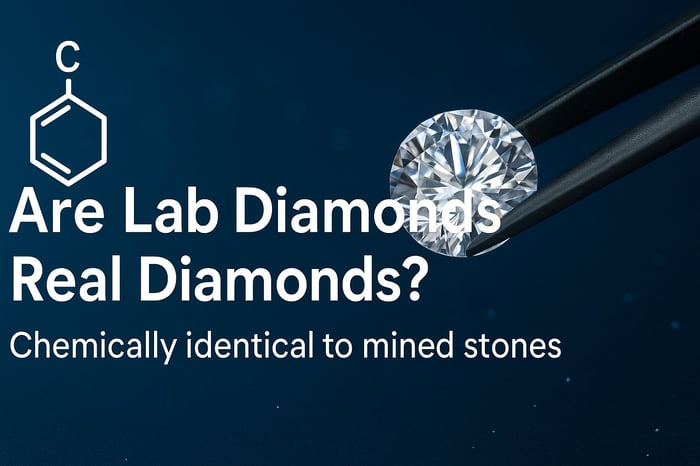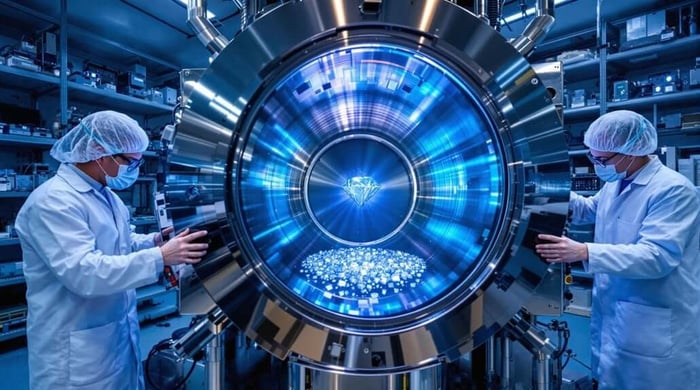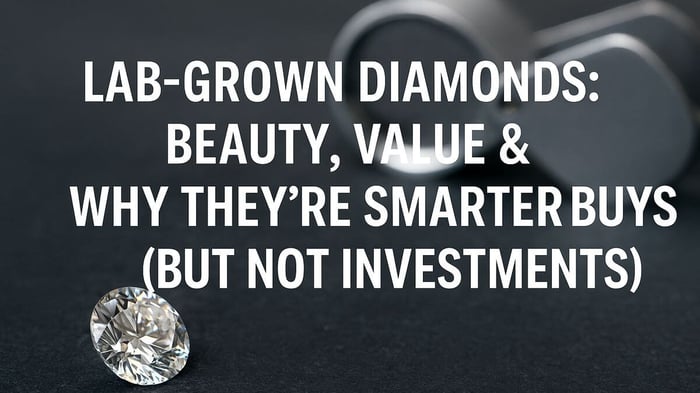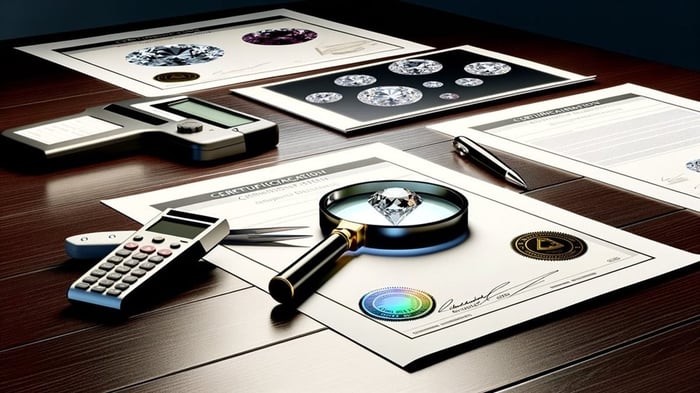In This Article
- Key Takeaways
- What Are Lab Diamonds?
- How Lab Diamonds Are Made
- High Pressure High Temperature (HPHT) Method
- Lab Diamonds in Fine Jewellery
- Popular Styles and Settings
- Choosing Lab Diamonds for Engagement Rings
- Ethical and Sustainable Advantages
- Lab Diamonds Market Overview
- Future Prospects for Lab-Grown Diamonds
Lab diamonds are gradually reshaping the landscape of fine jewellery. Crafted in laboratories, these jewels offer the same physical, chemical, and optical properties as traditional diamonds. By utilising advanced technology to replicate natural conditions, they emerge as an appealing choice for those valuing beauty and ethical considerations.
Known for their ethical and sustainable advantages, lab-grown diamonds reduce the environmental impact and social issues associated with traditional diamond mining. Due to their sustainable production, they have gained preference among consumers looking for eco-friendly materials without sacrificing quality or aesthetics. Popular styles and settings for these diamonds parallel those found with mined diamonds, ensuring they fit seamlessly into any occasion.
Opting for lab-grown diamonds, particularly for engagement rings, offers couples a modern alternative that aligns with contemporary values. As the market for these gems expands, they continue to gain recognition for their innovative production and accessibility.
Key Takeaways
Lab diamonds are chemically identical to mined diamonds.
They present ethical and sustainable benefits over traditional diamonds.
Lab-grown diamonds offer a modern and eco-friendly choice in fine jewellery.
What Are Lab Diamonds?
Lab diamonds are created in controlled settings using advanced technological processes. They exhibit the same chemical, physical, and optical characteristics as natural diamonds. These diamonds offer a sustainable and often more affordable alternative to mined diamonds.
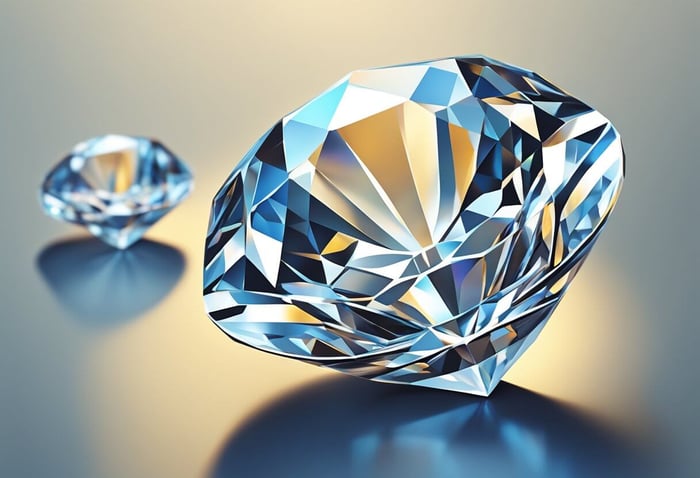
Lab Diamonds vs Natural Diamonds
Lab and natural diamonds share identical structures, mainly carbon atoms arranged in a crystal lattice. Both are graded on similar criteria, such as colour, clarity, and cut.
A key difference lies in their origin. Lab diamonds undergo production in a lab, whereas natural diamonds develop over millions of years beneath the Earth's surface. This natural formation gives mined diamonds inherent rarity and historical significance, contributing to their value.
Despite these differences, lab diamonds are real diamonds. To the naked eye, they are indistinguishable from mined diamonds.
They offer consumers an ethical choice, addressing environmental and ethical concerns associated with mining. In terms of visual and structural aspects, reliably distinguishing between the two without instrumentation is impossible. Labs create lab diamonds using techniques such as Chemical Vapor Deposition (CVD) or High Pressure High Temperature (HPHT). These processes replicate the natural conditions under which diamonds form, ensuring they share the same fundamental properties.
Ella Lab Diamond Solitaire Engagement Ring 1.50ct G/VS Platinum
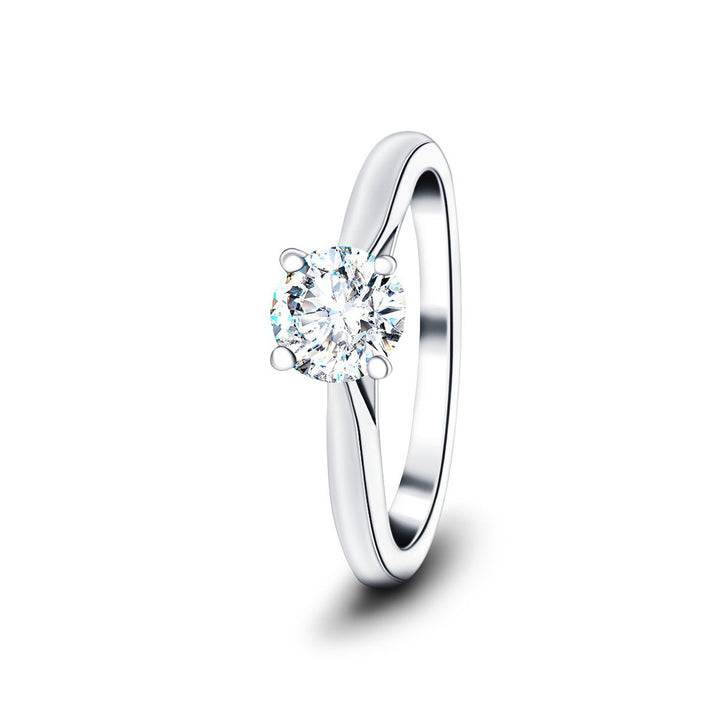
£1,171.00
£2,501.00
Fall in love with the timeless beauty of the Ella Lab Diamond Solitaire Engagement Ring, handcrafted in the UK with platinum. This ring features a stunning 1.50-carat G/VS-graded lab-grown diamond, certified by IGI. With a UK hallmark and a lifetime… read more
Laboratory Grown Diamond Properties
The properties of laboratory-grown diamonds are virtually identical to those of natural diamonds. They exhibit the same hardness, measuring 10 on the Mohs scale, and possess comparable brilliance, resulting from their ability to refract light.
Chemical composition is another aspect where both diamond types align. Both diamond types consist of carbon atoms and share the same crystal structure. Lab diamonds are available in various cuts and sizes, allowing for customisation in jewellery design.
These diamonds show identical thermal and electrical conductivity when tested, making them indistinguishable from mined diamonds using standard gemological tests. Many laboratories offer detailed guides and certifications to assure quality and authenticity.
How Lab Diamonds Are Made
Lab diamonds are created using precise technological processes that mimic natural conditions. The two primary methods used to produce these gems are Chemical Vapour Deposition (CVD) and High Pressure High Temperature (HPHT). Each method involves unique processes and conditions, from the materials used to the environment necessary for diamond growth.
Chemical Vapour Deposition (CVD) Process
In the CVD process, diamonds are grown in a vacuum chamber using a gas mixture rich in carbon, such as methane. The chamber creates an environment free from contaminants, allowing the diamond to form without impurities. The chamber generates a plasma at high temperatures, which breaks down the gas molecules and releases carbon atoms. These carbon atoms settle onto a diamond seed, crystallising over weeks into a diamond layer. This process ensures that diamonds have the same physical properties as natural ones.
High Pressure High Temperature (HPHT) Method
The HPHT method replicates the intense pressures and temperatures deep within the Earth’s mantle, where natural diamonds form. In this process, carbon is exposed to pressures above 50,000 atmospheres and temperatures exceeding 1,300 degrees Celsius. A press is used to apply this extreme force, causing carbon to transform into a diamond over several days. This method often begins with a diamond seed and involves a solvent catalyst that facilitates crystal growth. HPHT diamonds are chemically and physically identical to those forged in nature.
Raw Materials and Conditions
Both methods rely on high-purity carbon sources and specific environmental conditions for successful diamond formation. For CVD, gases like methane are used, which are decomposed into carbon atoms in a controlled vacuum setting. In HPHT, pure carbon is subjected to extreme pressures and temperatures with the help of a catalyst. Maintaining precise conditions throughout these processes is critical for quality and consistency. The vacuum environment in CVD and the intense conditions in HPHT are crucial for eliminating imperfections and achieving the desired diamond clarity and size.
Lab Diamond Cluster Drop Earrings 1.20ct D/VVS in 9k Rose Gold
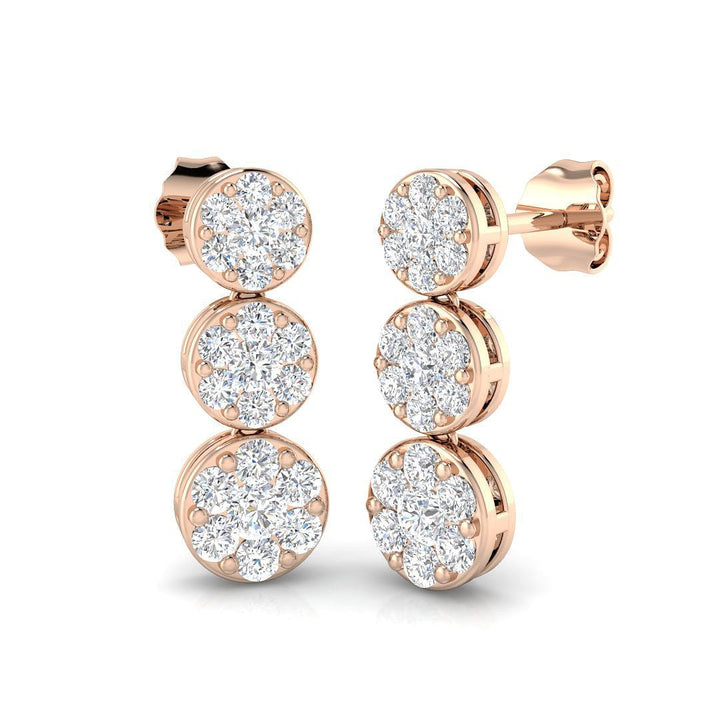
£769.00
£1,715.00
Elevate your elegance with these Lab Diamond Cluster Drop Earrings, boasting a total diamond weight of 1.20ct in D/VVS quality. Artfully designed in the UK, these earrings feature a classic and refined style, with three clusters of sparkling diamonds arranged… read more
Lab Diamonds in Fine Jewellery
Lab diamonds have become an essential part of contemporary fine jewellery. Their affordability and ethical production make them appealing for consumers seeking high-quality jewellery without the environmental and moral concerns associated with mined diamonds.
Lab-Grown Diamond Rings
Lab-grown diamond rings are celebrated for their brilliance and ethical sourcing. These rings have been crafted using advanced technology that imitates the natural diamond formation process. Consumers appreciate the sparkle and durability of these rings, making them a popular choice for engagement and wedding rings. Many retailers offer a wide range of designs, allowing individuals to choose pieces that reflect their style. Customisation options are often available, allowing consumers to create unique, one-of-a-kind rings. Overall, lab-grown diamond rings are both a stylish and conscientious option.
Necklaces and Pendants
Necklaces and pendants featuring lab diamonds offer jewellery enthusiasts a sophisticated yet sustainable choice. The elegant designs vary from minimalist pieces to intricate styles with complex settings. The ability to mix and match different styles to create a personal look attracts many consumers. The selection of necklaces and pendants ensures that something suits every taste and occasion. With the increasing availability of lab diamonds, it's easier than ever to find exquisite pieces that make a statement while aligning with ethical values. Practicality and luxury merge beautifully in these jewellery items.
Earrings and Other Accessories
Earrings and other accessories made with lab-grown diamonds have gained popularity due to their style versatility and ecological benefits. Whether opting for classic studs or more elaborate designs, customers can express their individuality while enjoying lab diamonds' durability and beauty. Retailers like After Diamonds offer a range of options, ensuring that consumers can find pieces to suit their lifestyle. These accessories enhance one's appearance and promote a commitment to a responsible luxury consumer experience. The advancement of lab-grown diamond production techniques continues to innovate the possibilities for earrings and other fine jewellery items.
Popular Styles and Settings
Lab-grown diamonds have gained popularity due to their sustainability and affordability. This section explores key ring styles and settings, highlighting these diamonds, such as classic solitaire designs, the favoured round brilliant cut, and popular metal choices including platinum, gold, and white gold.
Lab Round Brilliant Diamond Cross Pendant 1.00ct D/VVS in 9k White Gold
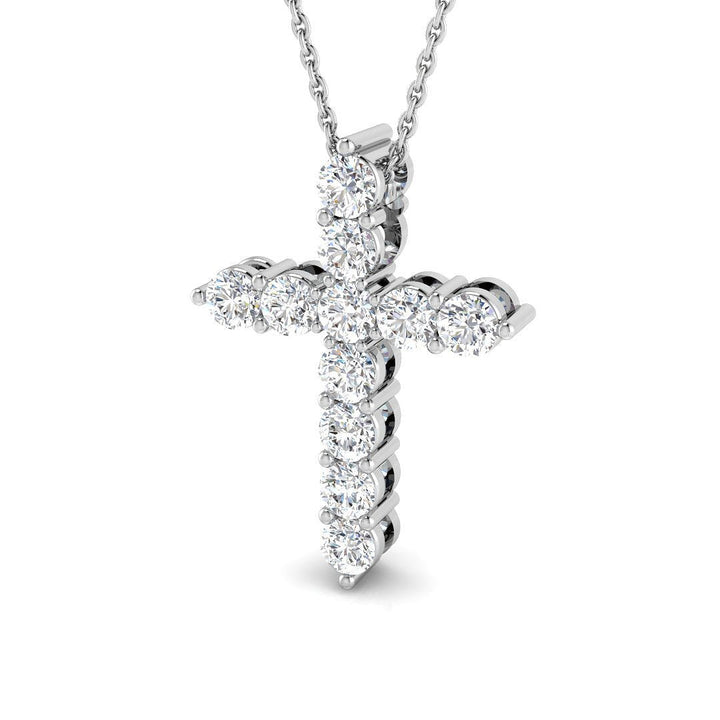
£662.00
£1,475.00
This exquisite Lab Round Brilliant Diamond Cross Pendant, boasting a total diamond weight of 1.00ct, exudes timeless elegance. Each diamond, of D/VVS quality, is masterfully claw-set, enhancing their brilliance. Handcrafted in the UK with meticulous attention to detail, it features… read more
Solitaire Designs
Solitaire designs remain timeless in the diamond world, emphasising simplicity and elegance. These rings typically feature a single lab-grown diamond as the focal point, allowing the stone's brilliance to shine. Many prefer solitaire rings for their versatility, as they easily complement various styles and occasions. Ideal for engagement and everyday wear, solitaire settings can be classic and modern, showcasing minimalist appeal.
One notable benefit of solitaire settings is their ability to highlight the diamond. The setting itself is designed to elevate the stone, allowing maximum light exposure, enhancing its sparkle. These rings can incorporate different band styles, such as plain or detailed, to further personalise the design.
Round Brilliant Cut
The round brilliant cut is one of the most popular diamond shapes, known for its exceptional brilliance and classic appeal. Featuring 58 facets, this cut maximises the diamond's ability to reflect light, making it a stunning choice for any setting. Lab-grown diamonds in this cut are often chosen for engagement rings due to their timeless beauty and maximum sparkle.
Round brilliant diamonds pair well with various settings like solitaire or halo, where smaller stones frame the central diamond. This cut is favoured for its adaptability to various ring styles, allowing individuals to customise their ring to match their preferences while maintaining a high brilliance and fire.
Metal Choices: Platinum, Gold, and White Gold
Choosing the right metal for a lab-grown diamond ring is essential for complementing its beauty. Platinum is a popular choice for its durability and hypoallergenic properties. It offers a sleek and modern appearance and is known for its ability to retain its colour and lustre over time.
Gold options include traditional yellow gold, which provides a classic warm hue, and white gold, which offers a contemporary look with its silvery-white finish. White gold is often alloyed with metals like nickel or palladium to enhance its strength and is typically coated with rhodium for added shine and protection. These metals allow for customisation, enabling the wearer to select a metal that best suits their style and skin tone.
Choosing Lab Diamonds for Engagement Rings
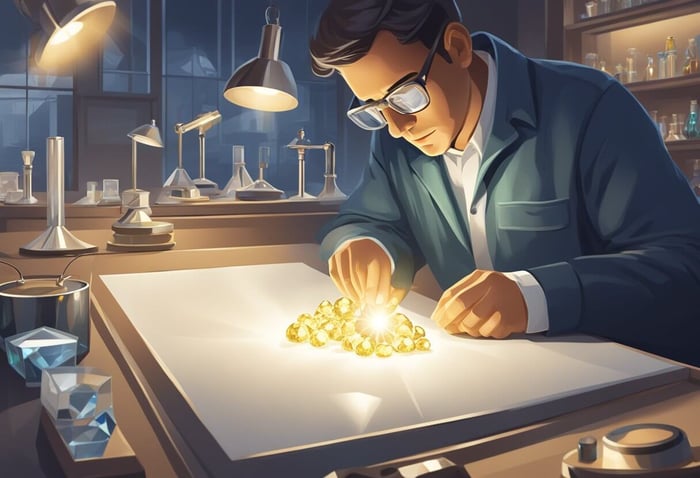
Choosing lab-grown diamonds for engagement rings offers a blend of ethical sourcing, beauty, and affordability. This section examines the unique features of lab-grown diamond rings, delves into their lifespan and properties, and considers their luxurious appeal.
Lab-Grown Diamond Engagement Rings
Lab-grown diamond rings are gaining popularity among couples seeking ethical and sustainable options. These diamonds are chemically and visually identical to natural ones, as their creation process replicates the conditions under which natural diamonds form.
The main difference lies in their origin. As a result, lab-grown diamonds are typically more accessible at a lower price point than their mined counterparts, allowing couples to allocate their budget to other significant elements of their engagement.
Age and Longevity
The age and longevity of lab-grown diamonds are among their appealing characteristics. Structurally, these diamonds are as durable as natural ones, with the same hardness and brilliance. This means they are well-suited for engagement rings intended to last a lifetime.
Lab-grown diamonds are as resistant to scratching and wear as mined diamonds. They maintain their sparkle and clarity, making them a reliable choice for individuals planning a future together. Their resilience ensures that the ring remains a cherished symbol of commitment through the ages.
Lab Solitaire Diamond Bracelet 1.00ct D/VVS Quality in 18k Rose Gold
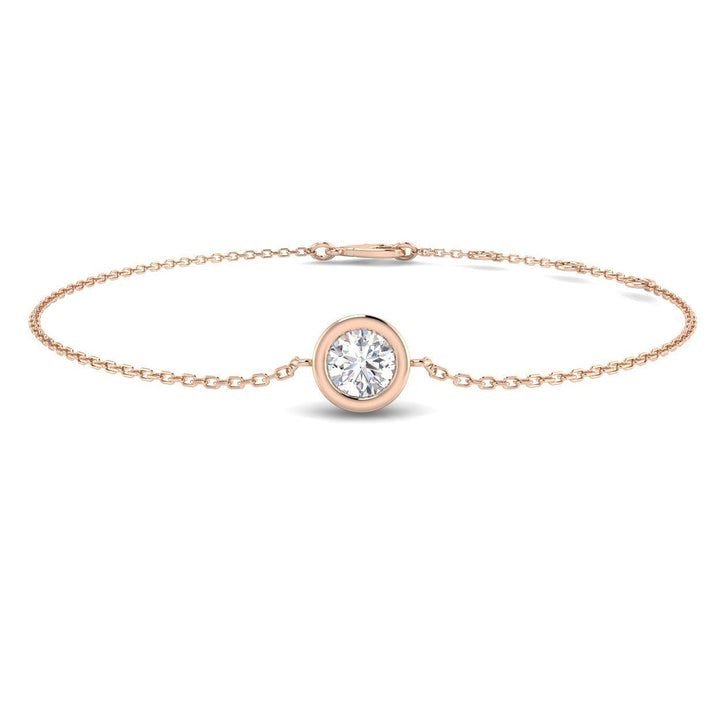
£1,348.00
£2,576.00
The Lab Solitaire Diamond Bracelet 1.00ct D/VVS Quality in 18k Rose Gold is a beautiful piece of jewellery. It features a 1.00ct lab-grown solitaire diamond that is D/VVS quality, which means that it is of the highest quality and has… read more
Luxury Appeal
Despite being more affordable, lab-grown diamonds do not compromise on luxury appeal. These gems offer the same dazzling brilliance that people expect from fine jewellery. Lab-grown diamonds' ethical and sustainable aspects add to their allure, catering to environmentally conscious consumers.
Luxury is often associated with rarity and prestige, so lab-grown diamonds provide a modern interpretation of these themes. Their traceability and environmentally friendly production aspects minimise ethical concerns, enhancing their attractiveness among buyers who prioritise responsible luxury. The appeal of these diamonds lies in their ability to merge tradition and innovation seamlessly.
Ethical and Sustainable Advantages
No mines, no murky origins — just pure brilliance.
Lab-grown diamonds provide significant advantages both ethically and sustainably. These diamonds are produced in controlled conditions, minimising environmental harm and ensuring ethical sourcing.
Environmental Considerations
Lab-grown diamonds are known for their positive environmental impact. Lab-grown diamonds require far fewer natural resources to create than traditional mining, which can result in extensive land degradation and water pollution. The process also significantly reduces carbon emissions by up to 99%. Furthermore, laboratory conditions allow for renewable energy sources, lowering their ecological footprint. This makes them ideal for environmentally conscious consumers seeking high-quality gemstone alternatives without compromising sustainability.
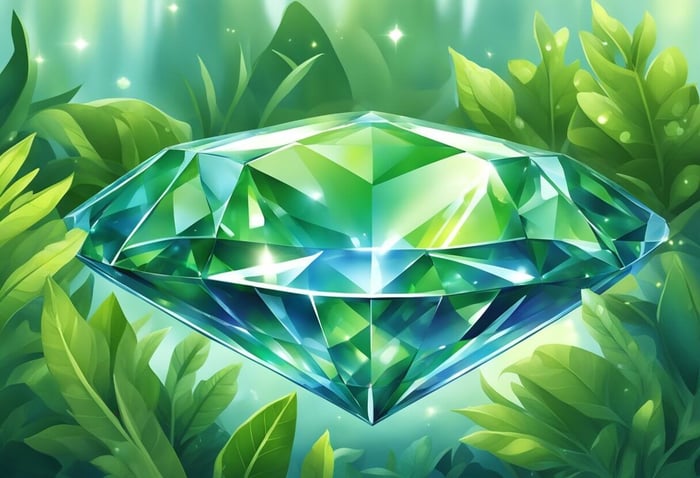
Sourcing Transparency
Lab diamonds offer enhanced transparency in sourcing. Unlike mined diamonds, which can be associated with unethical labour practices and conflict funding, lab-grown diamonds eliminate such concerns by ensuring a traceable production process. Created in laboratories, they avoid the complexities and risks of mining in conflict zones. This approach ensures that consumers can be confident that their purchase supports fair and responsible practices. Brands that produce these diamonds often provide detailed information about their creation process, which helps maintain transparency and provide assurance to discerning buyers.
Lab Diamonds Market Overview
The lab diamond market is experiencing robust growth and expansion, driven by technological advancements and increased consumer acceptance. As the market evolves, this segment highlights current market trends and prospects shaping the industry.
Current Trends in Lab Diamond Jewellery
Lab-grown diamonds have carved a significant niche in the global jewellery market. In recent years, they have transitioned from representing just 1–2% of the market share to approximately 50%, as observed in places like the UK. Consumers are attracted to lab diamonds due to their ethical sourcing and affordability, often priced around 90% less than natural diamonds at the point of manufacture. The price gap may widen with potential 50-80% reductions.
Retailers increasingly stock lab-grown gem options, appealing to environmentally conscious buyers. This shift reflects consumer preference for sustainability, particularly among younger generations who value sustainability and transparency. The jewellery industry continues to leverage this trend by promoting lab-grown diamonds as an eco-friendly and cost-effective alternative to mined diamonds.
Future Prospects for Lab-Grown Diamonds
The future of lab-grown diamonds looks promising. By 2025, they should comprise 20% of the global diamond market. Projections indicate the market value could grow from $25.89 billion in 2024 to $74.45 billion by 2032. As production technology improves, costs will decrease further, enhancing their competitive edge.
With increased investment in research and development, lab diamonds can offer customizability, attracting jewellers and consumers alike. This potential for personalisation and environmental benefits positions lab diamonds as a viable choice in personal and luxury markets. Companies must adapt to these emerging trends to remain competitive and relevant.
Lab Diamond Three Stone Bangle 0.33ct in D/VVS 9k Yellow Gold
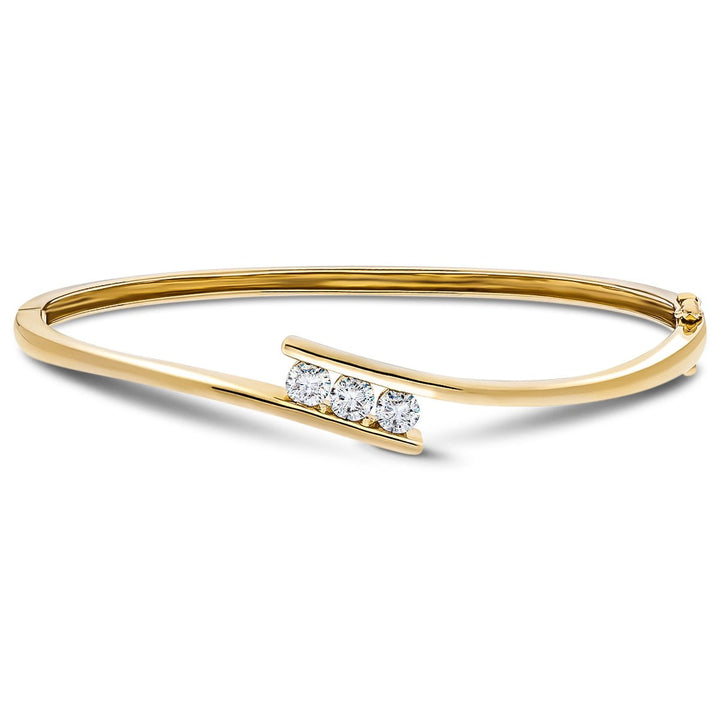
£1,191.00
£1,695.00
Introducing the Lab Diamond Three Stone Bangle, a masterpiece of modern design and elegance. This stylish bangle features 0.33ct of real diamonds in a tension setting, ensuring each stone is showcased in its full brilliance. Crafted in 9k yellow gold… read more
Discover the Brilliance for Yourself
Explore our stunning lab-grown diamond collection — same sparkle, better value, zero compromise. Find the perfect piece that’s as real and radiant as you are.
Explore our stunning lab-grown diamond collection — same sparkle, better value, zero compromise.


